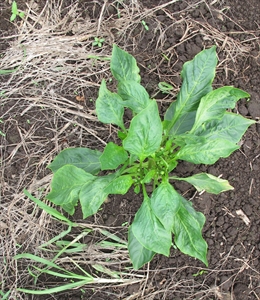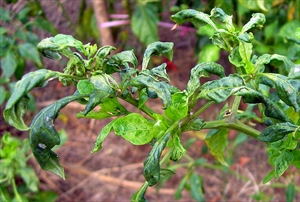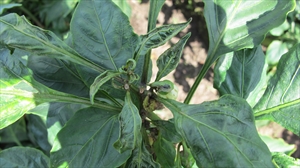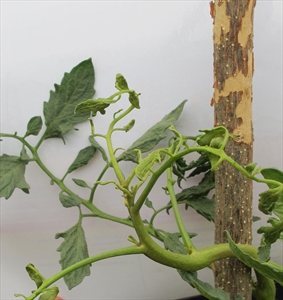Capsicum broad mite
Pacific Pests, Pathogens and Weeds - Online edition
Pacific Pests, Pathogens & Weeds
Capsicum broad mite (049)
Polyphagotarsonemus latus. Previously known as Hemitarsonemus latus.
Asia, Africa, North, South and Central America, the Caribbean, Europe, Oceania. It is recorded from Australia, Fiji, Guam, New Zealand, Papua New Guinea, Samoa, and Solomon Islands.
Capsicum, chilli, tomato are the main hosts, but also on many other crops, e.g., avocado, bean, eggplant, mango, papaya, and potato.
Mites damage the outer cells of the leaf as they feed on the plant sap. The leaves become distorted, bronze coloured, stiff, and rolled under at the margins (Photos 1-4). Tomato plants show a distinctive stem distortion with thin twisted leaves. Dieback is a common result from mites infesting chilies, capsicum and tomato.
The mites infest the youngest leaves of the bud; they are too small (less than 0.25 mm) to be seen with the eye, and a microscope or powerful hand lens is needed.
The eggs are laid singly on the underside of the leaves or fruit. These hatch giving rise to larvae with six legs, later they have eight as they develop into nymphs. The males are yellowish brown whereas the females are yellowish green. The life cycle takes a week or less.
Whereas the larvae feed close to where the eggs were laid, the adults migrate to the young leaves in the bud to feed. Broad mites spread by walking short distances; they are spread over long distance by wind as well as on the bodies of insects.
The mite causes a common problem on chillies, capsicum, and tomato. The symptoms - distorted, crinkled, stunted leaves - look as if the plants have a virus infection or, perhaps, suffering the effects of herbicide damage. Later, flowers drop, leaves fall, and fruits are distorted, and there is loss of yield. In extreme cases, plants are killed by the infestation. Damage to tomato is frequent when grown in enclosures (Photo 5). In this case, yield is very poor or non-existent.
Look for the distorted, stiff, discoloured leaves, on stunted plants showing dieback and early death.
NATURAL ENEMIES
In many parts of the world, predatory mites control broad mites, but the situation in Pacific island countries is unknown.
CULTURAL CONTROL
Before planting:
-
Avoid planting new crops next to those already infested with mites, otherwise the mites will spread to the new crop at an early age, and plants may become severely damaged.
-
Avoid planting new crops downwind from those infested with mites, as the mites will spread on the wind to the new crop.
During growth:
-
Often one or two plants show symptoms before the rest of the plants are infested. Remove the plants with symptoms to stop spread to other plants in the plot. Alternatively, threat the infested plants with miticide (see under Chemical Control).
After harvest:
-
Pull out the plants, burn them, and leave a week or two before planting another crop.
CHEMICAL CONTROL
Miticides are available for the control of broad mite, but these chemicals are seldom available in Pacific island countries. Garlic is said to be effective against mites, and other natural products are derris and sulphur. Abamectin is a relatively new product from the soil bacterium, Streptomyces spp. Sprays of white oil (petroleum oil) may also be effective (see Fact sheet no. 56).
____________________
When using a pesticide, always wear protective clothing and follow the instructions on the product label, such as dosage, timing of application, and pre-harvest interval. Recommendations will vary with the crop and system of cultivation. Expert advice on the most appropriate pesticides to use should always be sought from local agricultural authorities.
AUTHORS Helen Tsatsia & Grahame Jackson
Information from CABI (2019) Polyphagotarsonemus latus (broad mite). Crop Protection Compendium. (https://www.cabi.org/cpc/datasheet/26876); and Fasulo TR (2019) Polyphagotarsonemus latus (Banks). Featured Creatures, Entomology & Nematology. UF/IFAS, University of Florida. (http://entnemdept.ufl.edu/creatures/orn/broad_mite.htm); and from Sparks A, Riley D (2008) Polyphagotarsonemus latus. BugwoodWiki. (https://wiki.bugwood.org/Polyphagotarsonemus_latus).
Produced with support from the Australian Centre for International Agricultural Research under project PC/2010/090: Strengthening integrated crop management research in the Pacific Islands in support of sustainable intensification of high-value crop production, implemented by the University of Queensland and the Secretariat of the Pacific Community.








